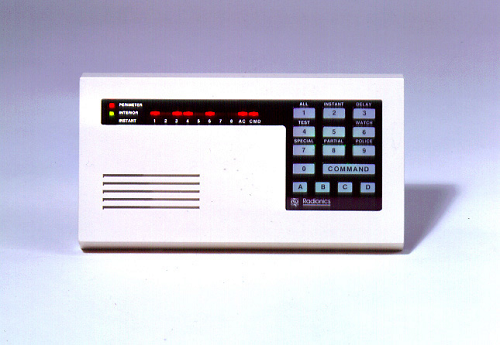- Home
- Compare Systems
- Cheap Systems
- Free Quotes
- DIY Systems
- Hardwired Systems
- Wireless Systems
- Smoke Detectors
- Medical Alarms
- Alarm Monitoring
- Cameras & Video
- Ademco
- ADT Security
- Brinks Security
- Broadview
- DSC Security
- FBI Alarms
- GE Security
- Honeywell
- Link Interactive
- Monitronics
- Moose
- Napco
- Protection 1
- Radionics
- Simplisafe
- Alarm Manuals
- Alarm System Parts
- Alarm Tools
- Troubleshooting
- FAQ
- Glossary
- Sitemap
- About Me
- Contact Me
Radionics Security System
Keypad Commands for Older Systems
If you have ever used a Radionics security system, you probably know that the older models use a series of commands to perform various functions. These control how the system is armed and disarmed, programming functions, panic alarms, and more.
Panels using this format include the Radionics D8112, D6112, and D4112, and use keypads like the D420, D620, 626, 630, and 636, D1252, D1255, and others.
For years these commands remained consistent throughout the entire line
of Radionics alarms. This consistent format meant that once customers
(and installers) learned the commands for one Radionics model, they
could use the same commands on any other model.
More recent models of Radionics alarm systems have strayed from this
command structure, which I think was a mistake. Having a set of "standard" commands just seems to make good sense to me.
In any case, this page
explains what the more popular original commands are, and how to use
them.
As always, I recommend you also get a copy of the Radionics
alarm manual for both your main panel and the keypads
that are installed in your home. For help finding a manual, see this page on Radionics alarm manual sources.
Note:
These functions only work on keypads having a “COMMAND” bar or a “CMD” button.
If your Radionics keypad doesn’t have one of these buttons, see my page on Radionics Home Security - Keypad Commands for Newer Systems, or see the user manual for your system, available below
Radionics Security System Keypad Commands
Command 1 – Arm All
Arms both perimeter and interior
protection, and provides delay time for entry/exit zones. Used when
leaving the home with no people or pets remaining inside.
Command 2 – Arm Instant
Arms
perimeter protection only, with no delay time on entry/exit zones.
Typically used to arm at night while staying home, and no other family
members are expected to arrive home.
Command 3 – Arm Delay
Like
Command 2, arms perimeter protection only, but preserves delay time for
entry/exit zones. Used to arm at night while staying home, and other
family members are expected to arrive home later.
Command 8 – Arm Partial
Arms
perimeter protection only, with delays on entry/exit zones, AND
bypasses any open perimeter zones. This is used when a bad door or
window contact prevents the system from arming with any of the other
commands.
Note:
The above functions of these four arming commands describe
“typical” Radionics security system operation. In other words, this is
what they do “right out of the box”.
The installing alarm company may have programmed some zones to behave differently than the above basic descriptions.
Command 4
By itself, Command 4 is used to acknowledge a trouble condition, and will silence a beeping keypad. For help in doing this, see how to stop a beeping Radionics keypad.
For
most models of Radionics security system, Command 4 can be followed by
other digits to perform diagnostic functions. Command 40, for
instance, will display the first of up to four trouble conditions in the
trouble event buffer on 6112 and related systems. Command 40 can then
be entered 3 more times to display the remaining trouble conditions in
the buffer, if there are more than one.
Command 47
This command performs the “smoke detector
reset” function on Radionics fire alarm systems and on combined
burglary/fire panels with fire alarm monitoring. This reset momentarily
drops power to the 2-wire smoke detector loop, resetting tripped smoke
detectors to normal operation.
Check the burglar alarm manuals
for your specific Radionics security system and keypad for detailed use
of other Command 4 functions.
Command 5 – Code Programming
For 4112 and 6112 systems, Command 5 is used to reprogram a code. The format is:
- Command 5
- (Old code) Enter
- (New code) Enter
- (New code) Enter
The new code must be entered twice, and both entries
must match or the code will revert back to the old value. (Note that
some keypads may have an “ENT” key rather than “ENTER”.)
For the 8112 Radionics system, code changes are started by entering Command 55.
Since code changes on the 8112 can be tricky, please refer to the
detailed instructions in the D1252, D1255, or other Keypad User Manual.
Command 6 – Perimeter Watch Mode
Toggles the Watch Mode on and off. This is known as the
“Chime” feature on other brands of alarm system, and it causes the
keypads to emit a sound when any perimeter zone is faulted. Depending on
the model of Radionics security system, this sound can be a long or
short beep, or a pulse of rapid chirps.
Command 7 – Special
This is typically used as a 24-hour feature. It will sound the
sirens and keypads, and transmit a “fire panic” signal to the central
station for systems that report to an alarm monitoring service.
Command 9 – Police Panic
This is a 24-hour police panic button. Typically,
this sounds the sirens and keypads, and sends a “police panic” signal to
the central station for systems using home alarm monitoring.
The
behavior of both Command 7 and Command 9 functions can be changed
through system programming, and the specific fire and police response
(if any) can be controlled through special instructions in the central
station automation software.
Command 0 – Bypass a Point
Command 00 – Unbypass a Point
These two allow you to selectively bypass and unbypass individual points on a Radionics security system. They were rarely used in most installations, since the most common need for bypassing was a faulted point due to a bad switch or mis-aligned magnet. In this case, it’s simpler to use Command 8 to allow arming around the faulted point until service can be arranged.
Related Articles
Radionics Home Security - Keypad Commands for Newer Systems
Radionics Security Systems – How to Stop Beeping Keypads
Radionics Alarm Manual Sources
If you have an older system that's starting to have problems, you may be thinking about replacing it.
To find out how much a new system might cost, get some free price
quotes from alarm dealers in your area. Just answer a few questions
below, and you'll receive your quotes via email.
These quotes are absolutely free!
If you haven't done so already, get a few Free Home Security Systems Quotes from companies in your area.
This will give you a good idea of what it would cost to have a system installed, as well as how much you could save by doing it yourself.
Return to Home Security Systems Answers from Radionics Security System Keypad Commands
Return to Radionics Alarm Systems from Radionics Security Keypad Commands
Note: Feel free to print any of the articles on this site for personal, non-commercial use. Just look for this button:
If you found this website especially helpful, you might want to consider making a small donation. Since 2011, AzAlarmGuy has been providing free help and advice on home security systems to all of those in need.
Your gift, in any amount, will help me keep this website a free resource for anyone needing help with alarm system issues or questions.
Disclosure
I receive affiliate commissions from some of the companies and products I discuss. These commissions don't change the price that you pay.
Rest assured that this compensation does not influence my recommendations. I only endorse products and services that I truly believe to be an honest value for you, as a visitor to my site.
For more details, see my full disclaimer.







